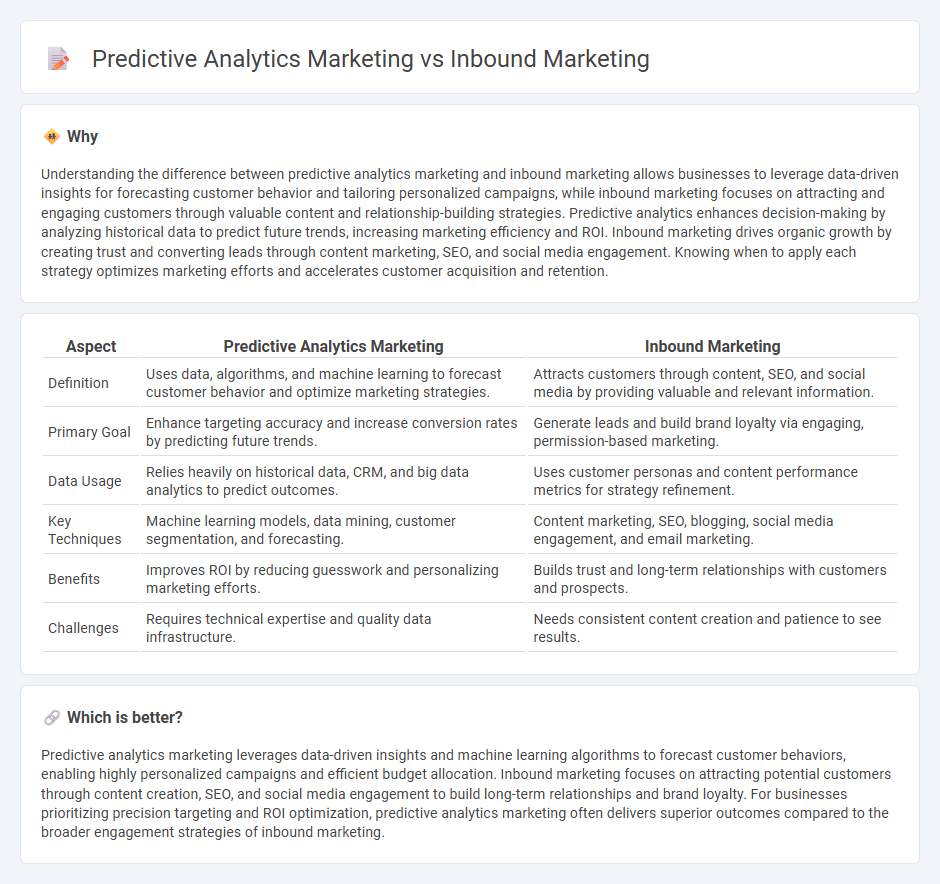
Predictive analytics marketing uses data, statistical algorithms, and machine learning to forecast future customer behaviors and optimize campaigns, driving higher ROI through targeted strategies. Inbound marketing focuses on attracting customers by creating valuable content and experiences tailored to their needs, emphasizing organic growth and relationship building. Explore how integrating these approaches can amplify your marketing effectiveness and customer engagement.
Why it is important
Understanding the difference between predictive analytics marketing and inbound marketing allows businesses to leverage data-driven insights for forecasting customer behavior and tailoring personalized campaigns, while inbound marketing focuses on attracting and engaging customers through valuable content and relationship-building strategies. Predictive analytics enhances decision-making by analyzing historical data to predict future trends, increasing marketing efficiency and ROI. Inbound marketing drives organic growth by creating trust and converting leads through content marketing, SEO, and social media engagement. Knowing when to apply each strategy optimizes marketing efforts and accelerates customer acquisition and retention.
Comparison Table
| Aspect | Predictive Analytics Marketing | Inbound Marketing |
|---|---|---|
| Definition | Uses data, algorithms, and machine learning to forecast customer behavior and optimize marketing strategies. | Attracts customers through content, SEO, and social media by providing valuable and relevant information. |
| Primary Goal | Enhance targeting accuracy and increase conversion rates by predicting future trends. | Generate leads and build brand loyalty via engaging, permission-based marketing. |
| Data Usage | Relies heavily on historical data, CRM, and big data analytics to predict outcomes. | Uses customer personas and content performance metrics for strategy refinement. |
| Key Techniques | Machine learning models, data mining, customer segmentation, and forecasting. | Content marketing, SEO, blogging, social media engagement, and email marketing. |
| Benefits | Improves ROI by reducing guesswork and personalizing marketing efforts. | Builds trust and long-term relationships with customers and prospects. |
| Challenges | Requires technical expertise and quality data infrastructure. | Needs consistent content creation and patience to see results. |
Which is better?
Predictive analytics marketing leverages data-driven insights and machine learning algorithms to forecast customer behaviors, enabling highly personalized campaigns and efficient budget allocation. Inbound marketing focuses on attracting potential customers through content creation, SEO, and social media engagement to build long-term relationships and brand loyalty. For businesses prioritizing precision targeting and ROI optimization, predictive analytics marketing often delivers superior outcomes compared to the broader engagement strategies of inbound marketing.
Connection
Predictive analytics in marketing leverages data-driven algorithms to forecast customer behavior, enhancing inbound marketing by tailoring content and campaigns to individual preferences. By analyzing historical and real-time data, marketers can optimize lead generation and customer engagement strategies, increasing conversion rates. This synergy allows inbound marketing efforts to be more targeted, timely, and effective, driving higher ROI and sustained customer relationships.
Key Terms
Inbound Marketing:
Inbound marketing leverages content creation, SEO, and social media engagement to attract and nurture potential customers organically. This strategy prioritizes building trust and long-term relationships by offering valuable information tailored to audience needs, resulting in higher lead quality and conversion rates. Explore deeper insights into inbound marketing techniques to maximize your customer acquisition and retention.
Content Creation
Inbound marketing revolves around creating valuable, relevant content tailored to attract and engage target audiences, emphasizing blog posts, videos, and social media. Predictive analytics marketing leverages data-driven insights to forecast customer behavior and optimize content strategies for personalized engagement. Discover how combining both approaches can enhance your content creation and marketing outcomes.
Lead Nurturing
Inbound marketing emphasizes lead nurturing through content creation, personalized emails, and social media engagement to attract and convert prospects organically. Predictive analytics marketing uses data-driven algorithms to score leads and forecast their behavior, enabling targeted nurturing strategies that increase conversion rates. Explore how combining these approaches can enhance your lead nurturing effectiveness and drive higher ROI.
Source and External Links
What Is Inbound Marketing? - HubSpot - Inbound marketing is a methodology focused on attracting loyal customers by aligning with their needs through valuable content, building lasting relationships rather than interrupting with traditional ads, and using channels like social media, email, and blogging to create meaningful engagement and drive business growth.
What is inbound marketing? - Optimizely - Inbound marketing organically pulls potential customers by providing relevant content through channels like SEO and social media, working in stages of attract, engage, and delight to boost lead generation, brand awareness, and conversions.
What is inbound marketing? - Adobe Experience Cloud - Inbound marketing attracts and engages customers with tailored, high-quality content addressing their questions and pain points, building trust and lasting relationships, and can be effectively combined with outbound marketing to maximize brand reach and conversions.
 dowidth.com
dowidth.com